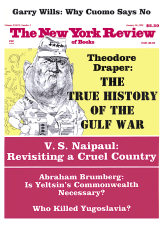In response to:
The 'Dark, Paradoxical Gift' from the April 11, 1991 issue
To the Editors:
To the readers of The New York Review who might be interested in how different the responses are in people who suffered amputations (mentioned in Professor Sacks’s review of John M. Hull’s book, Touching the Rock: An Experience of Blindness, NYR, April 11, 1991), I would like to offer the following:
As a very young student of the Viennese pianist Paul Wittgenstein—an artist who had lost his right arm in World War I—I had many occasions to see how involved his right stump was whenever we went over the fingering for a new composition.
He told me many times that I should trust his choice of fingering because he felt every finger of his right hand. At times I had to sit very quietly while he would close his eyes and his stump would move constantly in an agitated manner. This was many years after the loss of his arm and between 1933 to 1939.
Erna Otten
PS. His finger choice was always the best!
Rochester, Vermont
Oliver Sacks replies:
Although John Hull lays stress on the disappearance of visual memories and images with blindness, memories and images of the body, by contrast, may persist for decades when limbs are amputated. Such images (“phantom limbs”) may be intrusive, or painful—but they may also be of great service to the amputee. Such clearly was the case with Paul Wittgenstein.
Erna Otten’s reminiscence is quite fascinating, and raises deep questions about how specific perceptions, images, and memories of a limb can be preserved, even when it has long been missing. That such preservations do occur may perhaps be clearest in such a subject as a one-armed pianist—who may be strongly motivated to keep his image of the lost limb intact—but they occur, to some extent, in almost all patients with amputations. This was observed, and speculated upon, by the first physician to describe phantom limbs, Silas Weir Mitchell, and his 1872 account can hardly be bettered today:
[The majority of amputees] are able to will a movement, and apparently to themselves execute it more or less effectively…. The certainty with which these patients describe their [phantom motions], and their confidence as to the place assumed by the parts moved, are truly remarkable…the effect is apt to excite twitching in the stump…. In some cases the muscles which act on the hand are absent altogether; yet in these cases there is fully as clear and definite a consciousness of the movement of the fingers and of their change of positions as in cases [where the muscles to the hand are partially preserved]. (Weir Mitchell, Injuries of Nerves p. 357.)
It might be said that these are purely subjective accounts—patients telling us that they have a clear consciousness of the intended movement in their amputated limbs. With Wittgenstein, as Erna Otten’s story shows, this was not merely a subjective claim, for his power to “feel,” and (mentally) to test out, new fingerings with his phantom hand, was confirmed by the excellence of his actual judgments. One would like to know whether the movement of the stump while he was mentally playing had a purposeful quality, or some correspondence with the phantom motions, or the music played.
Before Weir Mitchell wrote on the subject, phantom limbs were regarded as purely psychic hallucinations conjured up by bereavement, mourning, or yearning—comparable to the apparitions of loved ones which mourners may experience for some weeks after their loss. Weir Mitchell was the first to show that these phantom limbs were “real”—neurological constructs dependent on the integrity of the brain, the spinal cord, and the remaining, proximal portions of the sensory and motor nerves to the limb—and that their sensation and “motions” were accompanied by excitation in all of these. That such an excitation indeed occurred during phantom motion was proved for him by its “overflow” into movements of the stump.
The last twenty years have seen great advances in neuroscience and biomechanical engineering, advances particularly pertinent to the “Wittgenstein phenomenon.” Neurophysiology has confirmed Weir Mitchell’s hypothesis that the entire sensory-ideational-motor unit is activated in phantom motions; and engineers are developing highly sophisticated artificial limbs, with delicate “muscles,” amplification of nerve impulses, servo-mechanisms, etc., which can be married to the still intact portion of the limb’s innervation, and allow phantom motions to be turned into real ones. The presence of strong phantom sensations, and of willed phantom movements, indeed, is essential to the success of such bionic limbs.
Thus it seems possible, in the not-so-far-off future, that a one-armed pianist may be fitted with such a limb, and with it be able, in actuality, to play the piano again. One wonders what Paul Wittgenstein (or his brother) would have thought of such a development. Ludwig Wittgenstein’s final book speaks of our first certainty, our grounding certainty, as being the certainty of our bodies, its opening proposition being, “If you do know that here is one hand, we’ll grant you all the rest.” Although Wittgenstein’s On Certainty is well known to have been written in response to the ideas of G.E. Moore, one must wonder whether the strange matter of his brother’s hand—a phantom, indeed, but real, effectual, and certain—did not also play a part in inciting Wittgenstein’s thinking.
This Issue
January 30, 1992



